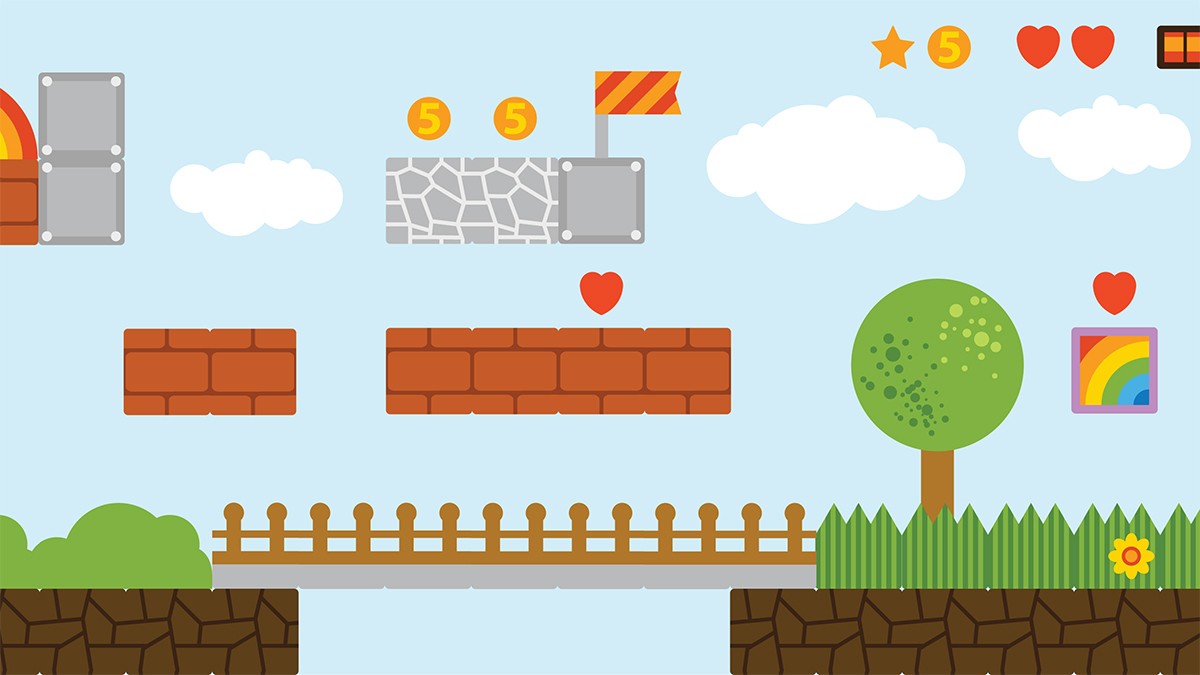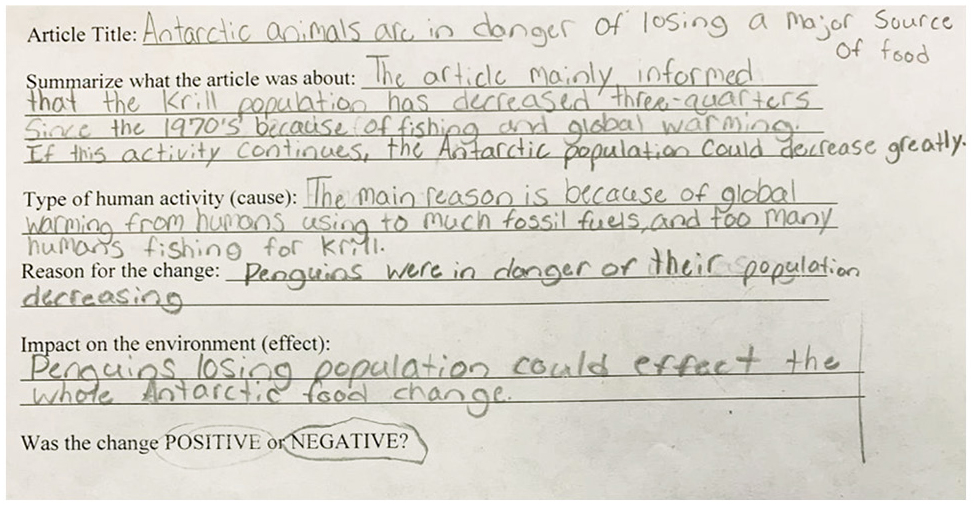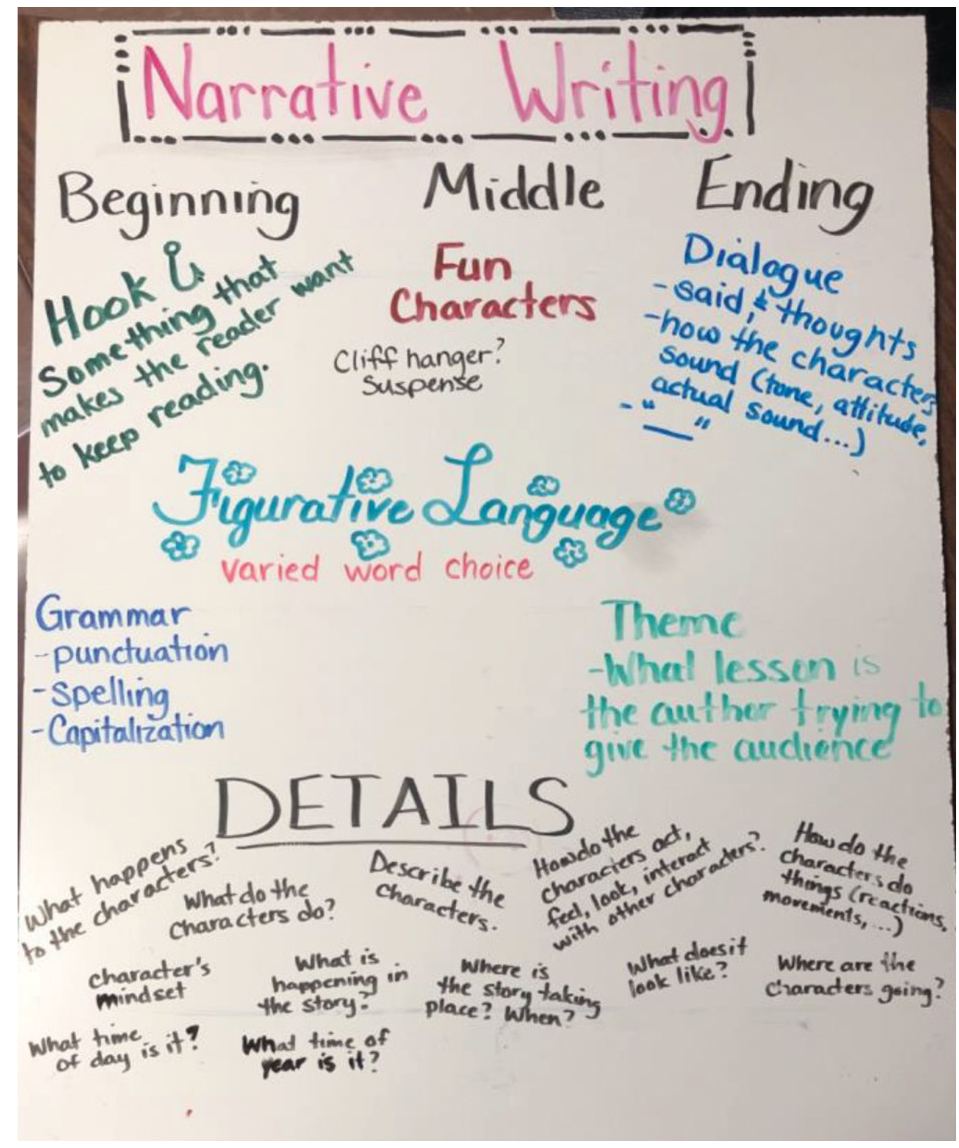feature
Animated Learning
Integrating ELA and coding into environmental science
Science and Children—May/June 2021 (Volume 58, Issue 5)
By Laura Robertson, Catherine Lamie, Renee Moran, and Chih-Che Tai

The purpose of this interdisciplinary project on human impacts on the environment was threefold. First, I sought to deepen students’ three-dimensional science learning by purposefully integrating related English Language Arts (ELA) standards. The reading and writing standards reinforced the science and engineering practice of obtaining, evaluating, and communicating information and the crosscutting concept of cause and effect (NRC 2012) within the context of Earth science. Second, I wanted to broaden students’ understanding of human impacts on the environment; this is important not only from an academic learning standpoint but also from a global citizenship standpoint. Finally, I wanted students to engage in a meaningful opportunity to use coding to demonstrate their science and ELA learning.
According to Kolb (2017), teachers should use a particular technology when it has the potential to extend, enhance, and engage student learning. For this project, students researched science content about human impact on the environment, communicated their findings through a traditionally formatted narrative story, and then used a coding program called Scratch (https://scratch.mit.edu) to create an animation. Students had to use critical thinking to design an animation that effectively used text and visuals to communicate science concepts in an engaging and coherent way. By incorporating a coding component in the communication portion, the depth of learning—and students’ enthusiasm—increased.
This lesson is aligned to fifth-grade NGSS and CCSS ELA standards; however, it was implemented in a fourth-grade classroom. The discrepancy exists because of slight differences between state and national standards.
Introducing Human Impacts (Days 1–2)
The project took place over eight days of 90-minute blocks for science and ELA instruction. Day 1 began with a whole-group discussion of the class’s recent novel study of Hoot! (Hiaasen 2005). We talked about how human activity to build a pancake house affected the environment in multiple ways and disrupted the habitat of endangered owls. This engaged the students in thinking about their experiences and prior knowledge related to human impacts on the environment. At that point I shared the central learning task with the students: Create a narrative story about human impact on the environment, and communicate the story through a coded animation. In order to complete the task, students would need to apply their science content knowledge to create a scientifically accurate story that also included basic components of narrative writing (e.g., descriptive details, sequencing, and characters).
To gather information prior to writing their narratives, the students explored a selection of articles and videos that highlighted the variety of ways that humans impact the environment (e.g., industry, agriculture, and everyday life) and that human impacts can be positive or negative. Each of the selected articles focused on a different human impact, such as dams interrupting salmon migration, pollution from fossil fuels, decreasing krill populations from climate change and overfishing, and highways dividing the habitats of bears. The articles introduced students to both problems and solutions to human impacts like fish ladders and wildlife crossings (see Online Resources for example articles from Newsela). A short summarizer guided students in identifying the important science content from each article with a focus on the cause-and-effect relationship represented (CCSS.ELA-Literacy.RI5.3; Figure 1). After reading and discussing the article as a whole group, students worked in their table groups to complete the summarizer and then glued it into their science notebooks.

Article summarizer.
Students also watched two five-minute videos about how humans and other animals change the environment and discussed the main ideas (see Online Resources for example videos from Crash Course Kids). The videos were paused to allow time for probing questions at several points in order to foster student engagement and idea sharing. For example, at one point, we paused on an image of a forested area that existed prior to the development of a major U.S. city. I asked the students, “What does that look like now? What did humans do? How does this happen on a small scale in our neighborhoods?” After the video was over, students were asked to share what information from the videos could be used in the writing of their stories. In addition to having students view videos and read articles, we also discussed our schoolyard as evidence of human impact. For example, we discussed the recent alterations to the school grounds. The school district added a parking lot to what used to be a portion of the playground. We also discussed how tree removal and recent playground equipment additions may have affected the local wildlife.
Communicating Information (Days 3–5)
On the third day of the lesson, students shifted their focus from gathering information to drafting narrative stories that illustrated human impact on the environment (CCSS.ELA.Literacy.W.5.3). When we brainstormed elements of narratives that people want to read, students shared ideas such as descriptive words reflecting all of the senses, figurative language that describes how characters feel, and dialogue between characters (Figure 2). The students also considered how to include factual information and use relevant scientific content terminology in their stories without switching genres to informational writing. One suggested strategy was to write from the perspective of one of the animals in the environment in order to convey human impacts from another perspective.

Narrative writing anchor chart.
At the end of the discussion, I provided students with a narrative story map graphic organizer (see Online Resources) that prompted them to consider the characters, setting, problem, and solution attempts. This reinforced the sequence of the cause-and-effect relationship as well as the possibility that human impacts could be positive or negative. I instructed students to first spend 20 minutes planning their stories. At the end of the planning time, students pitched their ideas to two classmates and asked for feedback (CCSS.ELA.Literacy.W.5.5).
After consulting with peers and making refinements based on feedback, the students were ready to begin drafting their stories. They worked in class to draft narratives that balanced factual information about human impacts on the environment with the components of narrative writing that engage the reader (Figure 3). To scaffold the writing process, I shared excerpts from students’ stories to discuss particular techniques that students had used or ways to improve their writing. Once students had completed their first drafts, they engaged in a second round of peer review. The process of drafting stories and sharing them with a classmate took approximately 45 minutes.

Example student narrative.
For the final step in communicating information, students transferred their word-based narrative to one with animation through coding (CCSS.ELA.Literacy.SL.5.5). For the first 15–20 minutes of class each day, students had been using their laptops to work on coding in Scratch, a free, easy-to-use resource (see Online Resources). For teachers who are new to coding, Scratch is a good starting place. The design is based on an XY coordinate plane, and the features are intuitive. Tutorials to help with Scratch are available online and can provide a more scaffolded approach for students and teachers if needed. Most of the students in my class had little or no experience using Scratch to create animations prior to the lesson, but there was a small group of students who had worked with the program during a related arts period. These students acted as peer experts and helped their classmates work through basic steps of coding.
To model an example of an animation, I shared one of my own about a duck and an oil spill. The students analyzed how the science content was communicated through animation using story elements such as scene changes, dialogue, and movements of the characters. Since the animation would serve as a performance-based assessment of students’ science and ELA learning, I then led the students in adapting the Scratch project rubric (Randall and Rusk n.d.) that would help them evaluate the quality of their coded stories. Students discussed important criteria needed in their stories and generated a list that was incorporated into the rubric that would assess science content, ELA content, and coding (see Supplemental Resources). Once the rubric was finalized, it was projected on the board so students could refer to it during their work. Students were challenged to change backgrounds, code purposeful movement of characters, and add dialogue (Figure 4).

Screenshot of student project in Scratch.
Reflecting on the Learning (Days 6–8)
On the final days of the lesson, students used the rubric to complete self- and peer-evaluations of how well their coded stories communicated information about human impact on the environment. From a science lens, students considered how well they (or their peers) had illustrated the cause-and- effect relationship in addition to how well they had used research for the solution that protected the animals while still allowing humans to continue with everyday activities. Relative to their coding, students suggested character changes, like free-form snipping characters from the internet when they could not find the exact one they wanted from the Scratch bank and adding more fluid movement choices to reflect character movements from the narrative. In the self-evaluation, one student realized her timing was off (a coding issue) and her dialogue was difficult for the audience to follow (a narrative issue). Based on the feedback, students revised and improved their animations by making them more informative, engaging, and easy to follow.
Final projects were shared through a Google site (see Online Resources). The last step of the project involved a whole-class discussion of the value of using animation to communicate scientific information. Guiding questions included How did coding the story require you to think critically about human impacts on the environment? and How could you see yourself using this type of skill (communicating information) in the future? During this discussion, students noted the animations were helpful to show human impact on the environment by providing an engaging format for the audience. Participating in the coding process helped them “realize their mistakes” and visually see what they left out of their narratives. Ultimately the general consensus of the group was that it was frustrating initially as they felt they were “bad at Scratch,” but as they continued to work through the process, they were proud of their accomplishments.
Differentiating and Assessing Learning
In order to differentiate for students, I incorporated more peer tutoring and feedback to support students in communicating information through the medium of animation. With purposeful pairing of students and clearly articulated expectations for how to provide feedback, this process allowed students to enhance their writing skills and clarify their science content. If needed, students with IEP modifications could have an abbreviated assignment that required fewer transitions or less dialogue in their animation. Performance tasks like this one give students who struggle with writing an opportunity to demonstrate learning in a different way. The coding engaged students that might otherwise dislike writing, and it scaffolded the process for them.
While I did not have students who were English Language Learners in this class, I considered how I would adapt the learning activities to work for them. The primary hurdle would be understanding the science content in English, so I would focus on translation technologies (our school uses Google Translate) in the early parts of the lesson so that students could comprehend the core ideas. Coding is almost a universal language, similar to math. I would introduce and integrate the coding the same with ELL students as I would with other students in the class. They may need a little bit more time and scaffolding to support the dialogue of characters, but I anticipate that they could successfully create the animation projects like their peers.
The final product served as an integrated, performance-based assessment of students’ abilities to effectively communicate information, their understanding of science content, and their application of English Language Arts (ELA) skills. In creating the animation, students strengthened their 21st-century communication skills, deepened their understanding of human impacts on the environment, and honed their skills for writing narrative stories, so the rubric to assess learning included all three components.
Conclusion
Throughout this project, the integration of ELA provided an additional perspective through which to consider the 3-D science learning. This led students to think more deeply when analyzing articles for science content, considering cause-and-effect relationships to sequence events in coding, and planning for audience engagement when communicating ideas. This project challenged students to think in new ways and led them to express a variety of emotions. Students identified value in the most common challenge they faced by stating that this type of project “forces you to think of what is important in your story” in order to convert it to an animation. What began as a frustrating project to some, who exclaimed initially “That’s hard!” and “I’m bad at Scratch!” turned into what one student described as “productive struggle that will help us get through [problems] later in life and won’t be as stressful.” In the end, students obtained and communicated information in a manner that reflects the digital world in which they live. ●
Online Resources
Crash Course Kids: “Big Changes in the Big Apple”
Crash Course Kids: “Big Changes in the Big Forest”
Narrative Writing Graphic Organizer (Problem/Solution)
Narrative Writing with Animation Google Site
Newsela: “Fish Tale on the Columbia River”
Newsela: “To Get to the Other Side: Bears Need Man-made Help Crossing Roads”
Download article summarizer at https://bit.ly/3ejANwG, rubric at https://bit.ly/3ax5uNK, and Standards connections at https://bit.ly/3ayuc0d.
Laura Robertson (robertle@etsu.edu) is an associate professor of science education at East Tennessee State University in Johnson City, Tennessee. Catherine Lamie is a science teacher at Haynesfield Elementary in Bristol, Tennessee. Renee Moran is an associate professor of reading education at East Tennessee State University. Chih-Che Tai is an associate professor and the assistant director of the Center of Excellence in STEM Education at East Tennessee State University.
Computer Science Multilingual Learners Environmental Science Interdisciplinary STEM Technology Elementary


